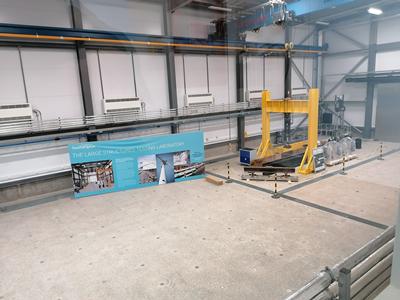
The University of Southampton will continue to lead the way in shaping the future of the UK’s major infrastructure with the opening of the ³Ô¹ÏÍøÕ¾ Infrastructure Laboratory on its Boldrewood innovation campus.
The centre will be officially opened on 27th September by Chief Executive of Network Rail, Andrew Haines.
Much of the infrastructure across the UK is in need of updating – in the transport industry, modern railways, roads and bridges need to adapt to increasing volumes of traffic moving at greater speeds. Whilst in the energy sector disused oil rigs need to be decommissioned safely and wind turbines need to be resilient in order to produce sustainable energy reliably. Designers of today’s infrastructure also need to consider new challenges such as climate change which will lead to longer periods of hot, dry weather as well as prolonged, heavier rainfall.
Current UK infrastructure inadequacies cost the UK an estimated £2m a day. The ³Ô¹ÏÍøÕ¾ Infrastructure Laboratory will provide researchers and students at the University of Southampton and around the world with state of the art equipment to build on their current world leading research to design infrastructure that can meet the demands of the modern world.
At the heart of the facility will be the cavernous Large Structures Testing Laboratory with a 4m deep reinforced concrete floor. This will be where the strength of heavy duty infrastructure components such as railway tracks, bridge beams and wind turbine blades will be tested to their limits under loads of up to 50 tonnes, increasing in future to 250 tonnes. Examples of what this could include are testing large beams for bending and shear strength and recording how different designs of railway track will cope with hundreds of thousands of trains, measured in just a few days.
The NIL also includes a state of the art 6m diameter geotechnical centrifuge which effectively compresses timescales by increasing gravity. This means researchers will be able to simulate the behaviour of an infrastructure component in service conditions over the course of its whole life in just hours or days.

William Powrie, Professor of Geotechnical Engineering at the University of Southampton said: “Infrastructure and urban systems underpin modern life. Our new facilities, which will be open to researchers from around the world, will support research to ensure that our infrastructure is affordable, adaptable, resilient and transformational. Our research in rail infrastructure has underpinned innovation and design improvements for several years.
“Decarbonisation of the infrastructure and the way we use it, to help avert the climate catastrophe, will be a major goal.”
Chief Executive of ³Ô¹ÏÍøÕ¾ Rail, Andrew Haines said: “The laboratory will increase our ability to keep trains running in the face of extreme weather, reduce infrastructure failures and downtime for repairs, and reduce the cost to the taxpayer of maintenance. It will make it easier to test new ideas, realistically test the demands of heavy rail use, and speed up the delivery of essential improvements.
“I’m looking forward to seeing the developments that come out of this and other partnerships, as we work together to give passengers the service they expect and deserve.”
As well as taking on new research projects, existing internationally significant research programmes led by the University of Southampton will continue in the Laboratory. These include Track to the Future which is developing railway track that will cost less and last longer and Structures 2025 which will model the behaviour of large components and structures under realistic scenarios they will face in service.
In keeping with the University’s vision for engineering knowledge to be passed on as well as continually developed by the next generation of engineers, the Laboratory will also provide a new teaching facility, further increasing the quality of learning and experience for students.
Southampton is part of the UK Collaboratorium for Research on Infrastructure and Cities (UKCRIC), comprising 13 universities carrying out world-leading research through a network of facilities and laboratories. The ³Ô¹ÏÍøÕ¾ Infrastructure Laboratory will form part of this network and represents an investment of £48m including funding from the Engineering and Physical Sciences Research Council (EPSRC), the Department for Business, Energy and Industry Strategy (BEIS), the University of Southampton and project partners.
David Richards, Professor of Ground Engineering and Head of the School of Engineering said:
“UKCRIC is a national investment that will support all infrastructure stakeholders – from owners, investors, academics and our future engineers – to have access to and to benefit from a network of joined-up national infrastructure laboratories. This collaboration works for the benefit of all citizens by providing safe, reliable and cost effective infrastructure for the future.”
Southampton also leads the Infrastructure Hub of the UK Rail Research and Innovation Network (UKRRIN), a network of 9 universities and 17 industry partners aiming to accelerate new technologies and products from research into market applications globally. UKRRIN offers industry access to purpose-built world-leading facilities and skills in a range of areas to support research, development and innovation for new technologies and products.
Network Rail is agreeing seven framework contracts with the universities of Southampton, Birmingham, Sheffield, Huddersfield, Newcastle, Nottingham and Loughborough to help the company deliver its R&D portfolio through the next five years. The universities are all part of the UKRRIN, a partnership between the rail supply industry and universities to establish the UK as a world-leading centre of excellence.
The framework contracts envisage a minimum £10 million investment for universities to help deliver Network Rail’s R&D portfolio and allow universities to maintain core teams and nurture talent.









